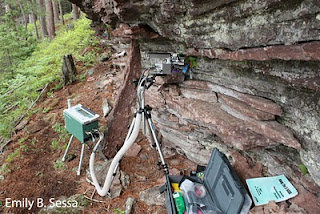While last summer's visit to the Hurons was purely a reconnaissance mission, this time we had a specific mission: data gathering. Specifically, I'm interested in a number of physiological traits relating to light and water use for my PhD research, and we were measuring the various species of Dryopteris that occur in the Hurons. The Huron Mountain Wildlife Foundationawarded me a research grant to hire an assistant, which was essential while working in the often-secluded habitats of these ferns, and it was great to have someone to help carry all the equipment! One of the main goals was to make photosynthetic measurements on all the species, using a fancy machine called a Licor LI6400. These first few pictures show the Licor set up and clamped onto a leaf of Dryopteris fragrans growing on a sandstone cliff. This was the most harrowing part of the whole trip, since it involved ferrying the Licor across a large lake in a rowboat, then scrambling with it up the rocky, pine-needle covered hill to get to these cliffs. Each LI6400 costs somewhere around $50,000, so perhaps you appreciate my concern.
I also need data on the light environments these plants experience naturally, so we took some short and long-term dataloggers along to capture information about incident radiation around the places. This was a bit of a challenge and required some MacGyvering with wire and duct tape for the cliff-dwelling D. fragrans, as you can see in the following photos.
One other way to measure a plant's light environment uses hemispheric photographs, which can be fed into computer programs with climate and light data for a given location. I find the photos taken above D. fragrans entertaining because most of them have some of the cliff in them. They also frequently have the plants themselves, since they're growing upside down attached to the rock overhangs.









No comments:
Post a Comment